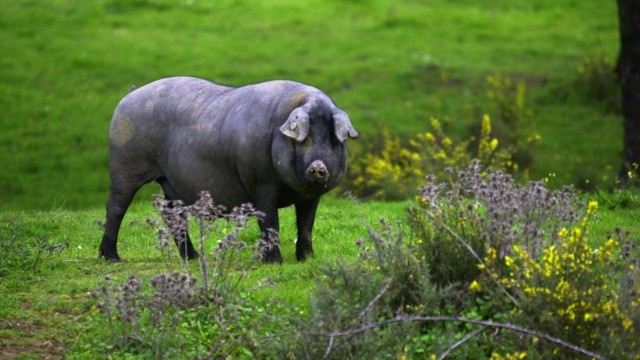Type the name of the breed you're looking for below
[wpdreams_ajaxsearchlite] Don't see the breed your're looking for? Click here and let us know!
Iberian pig
| Place of Origin | Spain |
| Origin | The Iberian pig is a traditional breed of the domestic pig (Sus scrofa domesticus) that is native to the Iberian Peninsula. The Iberian pig, whose origins can probably be traced back to the Neolithic, when animal domestication started, is currently found in herds clustered in the central and southern part of Portugal and Spain. The most commonly accepted theory is that the first pigs were brought to the Iberian Peninsula by the Phoenicians from the Eastern Mediterranean coast (current day Lebanon), where they interbred with wild boars. This cross gave rise to the ancestors of what are today Iberian pigs. The production of Iberian pig is deeply rooted to the Mediterranean ecosystem. It is a rare example in the world swine production where the pig contributes so decisively to the preservation of the ecosystem. The Iberian breed is currently one of the few examples of a domesticated breed which has adapted to a pastoral setting where the land is particularly rich in natural resources, in this case acorns from the holm oak, gall oak and cork oak. The numbers of the Iberian breed have been drastically reduced since 1960 due to several factors such as the outbreak of African swine fever and the lowered value of animal fats. In the past few years, however, the production of pigs of the Iberian type has increased to satisfy a renewed demand for top quality meat and cured products. At the same time, breed specialisation has led to the disappearance of some ancestral varieties. This traditional breed exhibits a good appetite and propensity to obesity, including a great capacity to accumulate intramuscular and epidermal fat. The high intramuscular fat is what produces the typical marbling; this, together with traditional feeding based on acorns, is what makes its ham taste so special. The production of meat products from Iberian pigs is quite distinct from other meat products obtained from selected pigs raised under intensive conditions on industrial farms, and it is a good example of high quality and highly prized meat product. Iberian pigs are interesting from a human biomedical perspective because they present high feed intake and propension to obesity, compatible with high values of serum leptin. In traditional management, animals ranged freely in sparse oak forest ('dehesa'), they are constantly moving around and therefore burn more calories than confined pigs. This, in turn, produces the fine bones typical of this kind of jamón ibérico. At least a hectare of healthy dehesa is needed to raise a single pig, and since the trees may be several hundred years old, the prospects for reforesting lost oak forest (dehesa) are slim at best. True dehesa is a richly diverse habitat with four different types of oak that are crucial in the production of prime-quality ham. The bulk of the acorn harvest comes from the holm oak (from November to February), but the season would be too short without the earlier harvests of Spanish oak and gall oak and the late cork oak season, which, between them, stretch the acorn-production period from September almost to April. |
| Purpose | Meat |
| Characteristics | The Iberian pig can be either red or dark in colour, if black ranging from dark to grey, with little or no hair and a lean body, thus giving rise to the familiar name pata negra, or "black hoof". |



